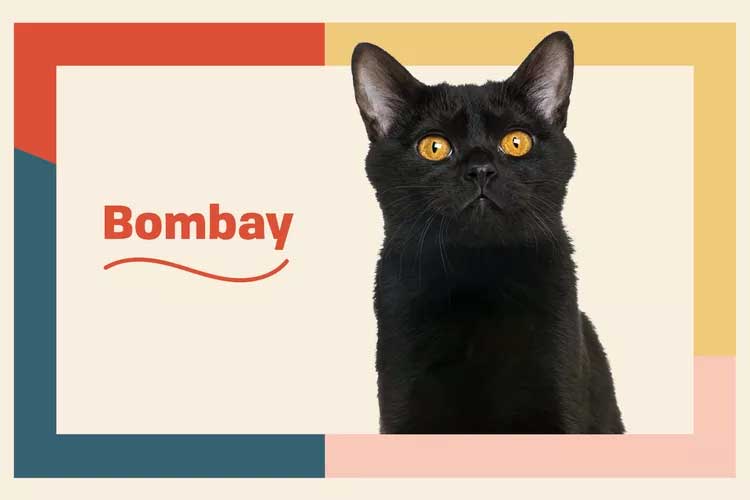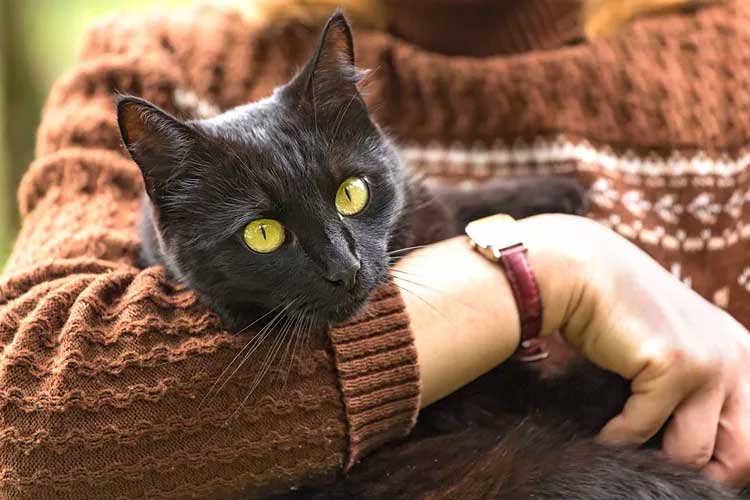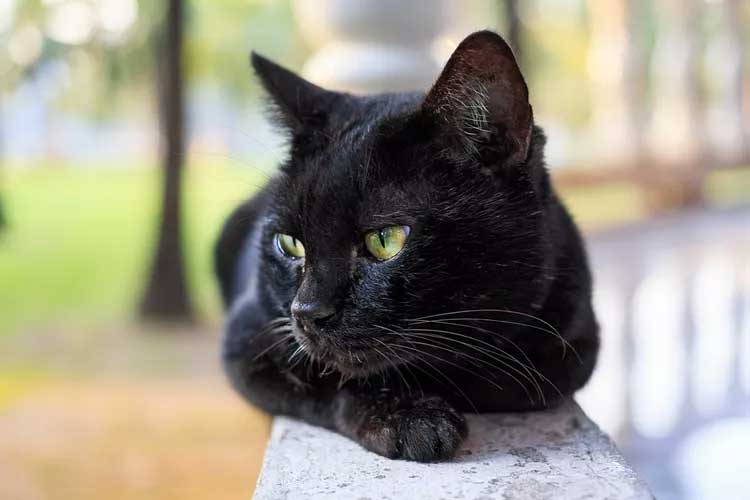Want a panther, but also enjoy both of your arms? The Bombay cat breed is the kitty for you!

Bombay Overview
| OFFICIAL NAME | Bombay |
| COMMON NAME | Bombay |
| PET HEIGHT | 9 to 13 inches |
| PET WEIGHT | 8 to 15 pounds |
| LIFESPAN | 9 to 15 years |
| GOOD WITH | cats, children, families, seniors |
| TEMPERAMENT | affectionate, sociable |
| INTELLIGENCE | high |
| SHEDDING AMOUNT | seasonal |
| PLAYFULNESS | high |
| ENERGY LEVEL | active |
| VOCAL LEVEL | when necessary |
| COAT LENGTH | short |
| COLORS | black / ebony |
| PATTERNS | solid |
| OTHER TRAITS | easy to groom, easy to train, friendly toward humans, friendly toward other pets, friendly toward strangers, good lap cat, high potential for weight gain, tolerates being picked up |
The Bombay is the perfect cat for anyone who hasever thought "I'd like to have a panther, but maybe smaller and less bitey."
Bred specifically to look like the Indian black panther, the Bombay is a mix of the Burmese and the black American shorthair. The result is a cat that does indeed resemble the big jungle cat, without having a single drop of wild blood in his pedigree.
Combining some of the best traits of both parent breeds, the Bombay has the hardiness, loyalty, and intelligence of the Burmese without being quite as overwhelmingly vocal and while sporting a gorgeous, solid black coat.
Appearance
They do look like little living room panthers. Easily the most noticeable thing about the Bombay is that purpose-bred coat. Short and sleek, the coat is solid black and very shiny. Many breeders liken the coat of a healthy, happy Bombay to patent leather.
Visually, the Bombay has a similar build to the Burmese, though slightly less stocky and a little longer instead. They are well-muscled cats with a round head; short, round-tipped ears; and medium-sized, round eyes that are gold to copper in color.
When the Bombay cat walks, he has a particular, swaying gait that further heightens his similarity to the black panther.
Temperament
The Bombay cat's personality draws a lot from his Burmese roots. The Bombay is a highly social, intelligent, people-driven cat. They form strong bonds with their family units and greatly prefer to be in the company of humans. Though, it's important to remember each cat is an individual with his own personality."Since Bombays were bred from Burmese and a black American domestic shorthair, they are apt to have a wide range of personalities [and] activity levels," says M. Leanne Lilly, DVM, DACVB, assistant professor-clinical at the Ohio State University Veterinary Medical Center. "The biggest driving factor for gregariousness, or being an outgoing, social cat, is actually in the father's genetics. So there's a wide range of individual variation. Most cat breed pages list them as social, affectionate, brave, playful, and good family cats."

Their typically playful, yet restrained nature makes them particularly good with children. They also do very well in households with other cats, as they quickly establish a pecking order within the household and live well in their place.
As a people-lover, the Bombay follows their human companions around a lot, observes all they do, and wants to be in the middle of as many things as possible. They are strong, agile climbers and jumpers, and they are extremely playful as younger cats. As they mature, the Bombay will mellow out some, appreciating a little couch time, but will still enjoy a game of fetch now and then.
Because of their highly social nature, Bombay cats don't do well on their own for extended periods of time, Lilly says. This is, of course, a non-issue for multi-cat households. But for single-cat households, stress issues may start to manifest themselves if the Bombay is left alone for more than a couple hours at a time.
Living Needs
Bombays are strong, agile climbers and jumpers, so a multi-level scratching post or climbing tower is appreciated. They're by nature active cats, so a variety of toys are good to have, especially ones that allow you to be active with them, as the Bombay loves engaging in activities and playing with their human companions.
Bombays can also be trained to walk on leashes, so if you want to spend some (supervised) time outside or take them for a walk, chances are your Bombay will welcome the fresh air and time outside with you.
Care
That short, sleek coat virtually takes care of itself. And while Bombays do shed a little, with traditional shedding seasons being a little heavier, a weekly brushing should be enough to keep most of their hair off your couch and clothes.Bombays can be prone to gingivitis, so brushing their teeth a couple times a week wouldn't be a terrible idea as well. If anything, at least provide some regular, tartar-fighting treats. A dental exam might be necessary at some point, too.
And, like all cat breeds, Bombays need their nails trimmed every couple of weeks, and their litter box should be kept clean.
Health
This is another area where their Burmese genetics help out. The Bombay is a relatively healthy breed with no major genetic dispositions for health concerns.That said, sinus issues can be a nagging problem, and keeping an eye on their gums and teeth is recommended.
"Being derived from the Burmese and with generally rounder faces, they may be prone to nasal problems such as sinus issues and asthma, which may also be related to allergies or just poor drainage in a less-elongated face," Lilly says. "They may also be at risk of gingivitis or dental disease if their dental alignment is somewhat compressed."
Also, the breed can get a bit chonky if their food intake isn't monitored, especially as they get older. To help combat this, many vets urge meal-style feeding over plopping a dish of food out and allowing cats to free feed.
"Overall, I tend to recommend meal feedings—generally twice a day—and having that food down for 15–20 minutes, then picking it back up again so the cat knows that's their window," says Michelle Beck, DVM, CCRT, CVA, of the Backlund Animal Clinic in Omaha, Neb. "In a multi-pet household especially, if you're doing meal feedings, then those are times you can specifically separate out those animals, so they each get a set amount of food for a set amount of time."

Beck also cautions owners to be mindful regarding the diets of cats who have been spayed or neutered.
"The bags of food that we purchase, the recommendations on the label on how much food to feed animals, that's for animals that are intact," Beck says. "But most of our pets nowadays are spayed or neutered, [and] removing those hormone processes from a cat's body changes how they metabolize food. Calories need to be reduced on average by 30 percent versus what's on the bag."
The average Bombay cat lifespan is 15 years, but because they tend to be so hardy, examples of well-tended cats living 20 years are not uncommon.
History
The Bombay is the brainchild of Nikki Horner, a breeder from Louisville, Ky., who wanted to create a breed reminiscent of the Indian black leopard. To achieve her look, she crossed Burmese cats with black American shorthairs. Her goal was a cat that had the muscular, solid build of the Burmese, with the shorthair's jet-black coat. She also specifically searched out shorthairs with golden eye colors to complete the look and, in 1965, succeeded in producing a full litter of black-haired, golden-eyed kittens that became the foundation of the Bombay breed.The breed was named after Bombay, India, in an effort to draw the mind towards the black panthers the cat is meant to emulate. While Burmese and American shorthairs are still accepted outcrossing partners for the breed, the Bombay is a genetically distinct breed that was given recognition by the Cat Fanciers Association (CFA) in 1970 and The International Cat Association (TICA) in 1979.
Fun Facts
Despite being bred for their patent-black coats, some Bombay kittens are born pure white. These coats darken within their first year.The Bombay's solid-colored coat isn't the only thing that's black. Even their whiskers, noses, eyelashes and foot pads are inky black.